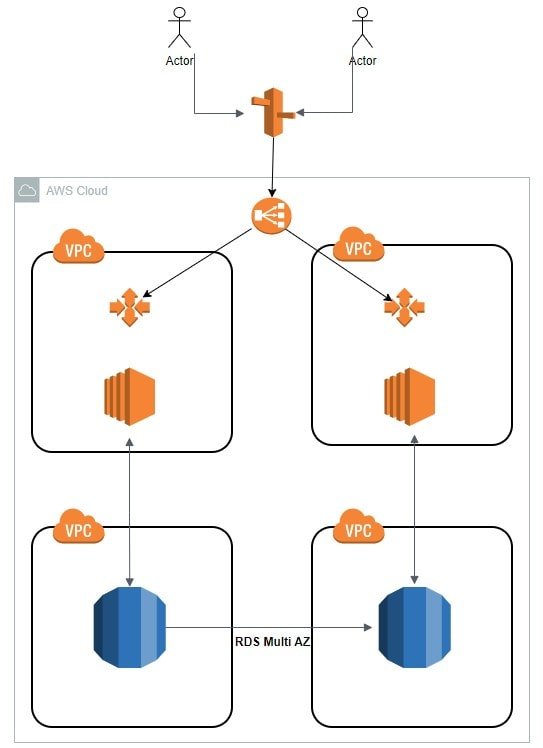Wondering why AWS High Availability Architecture is worth learning? Read on to know how to achieve high availability when working with AWS services!
In this AWS Tutorial, we are going to explore everything about the High Availability definition in AWS.
What Is AWS High Availability?
The High Availability (HA) of AWS determines the sophistication of real-time communication even when there is a disruption of service in one AZ.
People interested in AWS services often look for High availability to utilize cloud services. They want to find solutions that optimize their businesses and improve customer experience.
AWS incorporates many methods to enable the High Availability of its services. From improving the design of the systems to increasing scalability, it ensures AWS high availability services for the users.
AWS offers HA architecture through software solutions that protect the cloud data, provide reliable performance, and minimize downtime.
AWS High Availability Best Practices
The following are the best practices to ensure AWS’s High Availability:
- Increase HA by enabling automated monitoring and failure detection.
- Improve the system design for no single point of failure. Use N+1 or 2N configuration for redundancy to eliminate a Single Point of Failure (SPOF). N+1 for load balancing of active-active nodes. 2N for active-standby nodes.
- Incorporate failover mechanisms for stateful and stateless elements.
- Use a load balancer cluster to scale the services for AWS High Availability.
- Test system availability by instrumentation.
- Use manual mechanism operation methods to respond and recover from failures.
- Include at least two Availability Zones to create an AWS HA Architecture.
AWS High Availability Architecture
AWS prioritizes HA Architecture to streamline its performance.
They figure out the elements, dimensions, and AWS services that require tweaking to enable HA architecture, and they work on them to increase High Availability.
Elements
- Monitoring the systems to identify problems: The issues that degrade or disrupt service for AWS must be eliminated to ensure High Availability.
- Incorporating the practice of redundancy: Having multiple identical components within a system is critical to ensure SPOF does not affect the services. In case there is a failure, the redundant component can take over.
- Ensuring the Failover mechanism works: It’s not easy for a system to switch from an active component to a redundant one. A system that does this maneuver flawlessly is the High Availability architecture AWS wants.
- Enabling the Failback mechanism: Redundant components are essential for AWA High Availability Architecture. If a system can return quickly to the original component from a redundant one, it is an efficient system. This determines that the failure point has been fixed.
Dimensions
AWS enables High Availability for a cloud system by covering three dimensions:
- Computation of Resources: AWS provides HA architecture with the help of services like Amazon EC2. These services compute resources and increase HA features with the use of auto-scaling, load balancing, etc. It also delivers across Availability Zones by representing Amazon Data Center’s isolated areas.
- Management of Databases: Managed databases of AWS like Amazon RDS automate the deployment of databases. However, there’s always a replica in different Availability Zones. It guarantees that AWS HA Architecture works!
- Storage Services: AWS High Availability is also achieved using Amazon services for storage. Amazon S3, Amazon EFS, and Amazon EBS are some of the services with built-in High Availability. They store data automatically across Availability Zones, providing an unstoppable mechanism for AWS services.
AWS EFS High Availability Architecture
Amazon Elastic File System (EFS) works on the principle of High Available Architecture by providing backup database workflows.
If there is a failure within a system due to database access issues, the backup can take over until the workflow is restored.
Amazon EFS is highly reliable, scalable, and cost-effective—you do not have to worry about the failure of service because of a fully managed POSIX-compliant file storage system.
It would be best if you considered using AWS EFS for the following reasons:
- The Simplicity of Storage: EFS has database backups which is the main reason someone would use it. However, that’s not the only best thing about this storage. Amazon EFS works on the principle of POSIX-compliant storage, which enables the standard file storage associated with POSIX compliance. It means there is no need to create backups using fancy lines of code.
- Reliability of Backups: Customers restore data within a few weeks of backup. EFS offers reliable backup service so that the performance of AWS service is not affected. Reliability is also crucial to confirm that recovery won’t be a hassle. With high availability across Availability Zones, EFS provides data storage that protects data from failure issues.
AWS RDS High Availability Architecture
Amazon RDS is a managed database system for AWS users that offers High Availability architecture. AWS HA Architecture for RDS is enabled using Availability Zones and Regions.
- Availability Zones (AZ) work independently but stay connected using a high-speed network. They have one or more data centers that keep the AWS components active all the time.
- The Region has at least two AZs. Users have the option to store and back up data using different Regions. It strengthens the High Availability Architecture for RDS.
Amazon RDS uses multiple AZs to provision HA architecture. There is an automatic mechanism that backs up a database in different Availability Zones.
If the primary database fails to work, a replica stands by to receive requests to stop the service from shutting down suddenly.
On the other hand, if the database works fine but there is an issue with the AZ, the responsibility shifts to another AZ that does not have a disruption.
AWS High Availability Architecture VS Fault Tolerance Architecture
| AWS High Availability | AWS Fault Tolerance |
| Minimal service interruption leads to the need for redundancy. | There is no service interruption. |
| It is a combination of software and standardized hardware that minimizes downtime. | It used specialized hardware to detect faults and use redundancies as per need. |
| Redundant components are considered a system-wide resource. The service responds as soon as there is an issue with the software or application. | It does not respond to software failures. Fault tolerance is only available for hardware faults like processors, power supply, etc. |
AWS High Availability Patterns Multi-Region Architecture
A primary Region with two Availability Zones (AZ) is the pattern that works for the multi-Region architecture of AWS. With the production SAP Database and central services tiers, the system is highly available and fails over in case of AZ failure.
The secondary Region has the backup of the Amazon S3 database, Amazon Machine Images, and Amazon EBS Snapshots. Therefore, if there is a Region failure, the second Region will provide the service to keep the system uninterrupted.
Why Use Multi-Region Architecture?
If you need a set time for the recovery of a system and a guarantee of High Availability, you should consider using a multi-Region architecture pattern.
However, the additional cost of production, SAP Database deployment, and central services tiers within two primary Region AZs can be overwhelming. You should opt for this pattern if you are sure that you can accept the cost. Here are some reasons to use this pattern:
- Both Availability Zones have 100% compute capacity for the production SAP Database and central services tiers.
- Amazon EC2 is configured for auto-recovery. In case of an undetected hardware failure, the instances that are not under the protection of a third-party cluster solution remain protected with this feature.
- Amazon EBS has the data from the SAP Database, which is replicated for both AZs. They use block-level replication or database replication capability to complete this task.
- Amazon S3 regularly backs up the data for the SAP Database.
- In the case of Availability Zone or Amazon EC2 failure, Predictable Return to Service (RTS) and Low Mean Time to Recovery (MTTR) is engaged.
- It provides the required computing capacity regardless of the Availability Zones in the primary Region.
- If an Availability Zone fails in the primary Region, the architecture does not depend on Amazon S3 to restore data.
- The architecture protects the High Availability feature from degradation or total failure of Availability Zones or primary Regions.
how to configure high availability in AWS

The above diagram gives a simple approach to how we can configure high availability in AWS. This is just a simple example to give you an idea.
Users when they send the request it routes through Route 53 to the Application Load Balancer.
Load Balancer always keeps checking if there is any problem in any of the fleets and it never sends traffic to the affected fleet this is how we maintain HA in the application.
As far as DB is concerned we have used a MUlti AZ DB which keeps syncing Data to the secondary AZ and in case the Primary AZ goes down the Secondary AZ DB takes over without interrupting the user experience.
Conclusion
AWS High Availability Architecture is the best approach to providing non-stop services.
Amazon uses multiple methods to ensure that a user never has to deal with the failure of a database, storage, or computation.
By incorporating Availability Zones and Regions with multiple AWS services, all users can enjoy High Availability Architecture for their work.
FAQs: AWS High Availability Architecture
Q: What Architecture Does AWS Use?
Amazon EC2 is the architecture that AWS uses as a High Availability Architecture. It is the foundation of AWS HA.
AWS EC2 holds enough power to handle multiple virtual devices without failing. It enables this service as per demand!
Q: What Is HA Architecture In AWS?
AWS High Availability Architecture is a global infrastructure that enables high availability across different cloud workloads.
Everything within AWS services can be optimized for HA architecture from storage to computation and databases.
Q: How Would You Architect a Design for Fault Tolerance?
One can manage fault tolerance by introducing redundancy within a system.
If you want to ensure that a Single Point of Failure (SPOF) does not stop the AWS service mid-task, you must introduce redundant components. They make a system Highly Available.
Q: Is AWS S3 Fault-Tolerant?
Yes. Simple Storage Service (S3) provided by Amazon is a fault-tolerant and durable data storage service.
It makes the service Highly Available. AWS takes the responsibility to stay fault-tolerant and keep the system available for all users by using redundancies for fault tolerance.
Q: AWS high availability services Example?
Route 53, Application Load Balancer, and Multi-AZ Databases are a few of the HA Service examples.
Q: AWS high availability architecture white paper?
Please refer to the diagram in the above article.
Q: Which AWS service or feature is highly available by default?
Lambda, Kinesis, API Gateway, and SQS are a few of the services that are Highly Available by default.
Q: what is an example of high availability in the AWS cloud?
Multi-AZ Database is an example of High Availability in AWS.

I am an Amazon Web Services Professional, having more than 11 years of experience in AWS and other technologies. Extensively working in various AWS tools like S3, Lambda, API, Kinesis, Load Balancers, EKS, ECS, and many more. Working as a Solution Architect and Technology Lead for Architecting and implementing the same for different clients. He provides expert solutions around the world and especially in countries like the United States, Canada, United Kingdom, Australia, New Zealand, etc. Check out the complete profile on About us.


